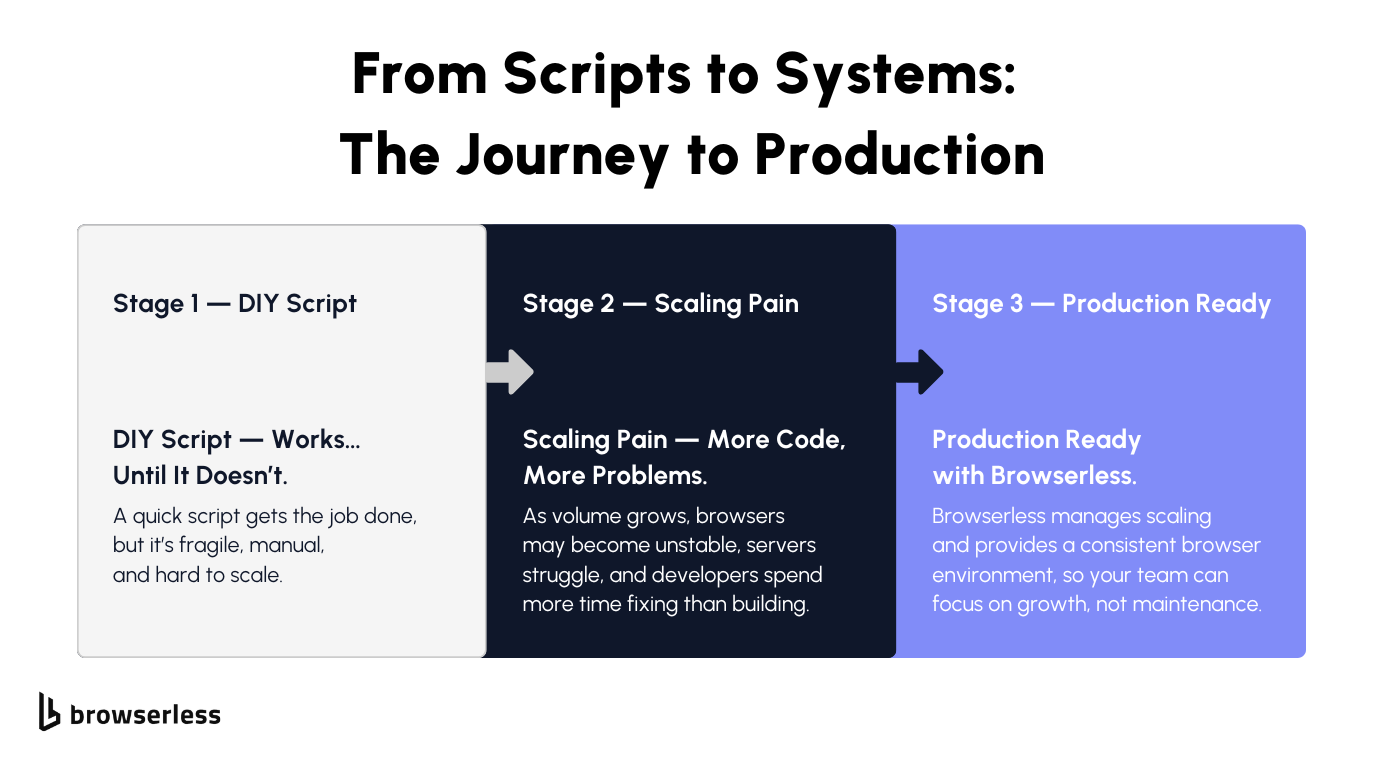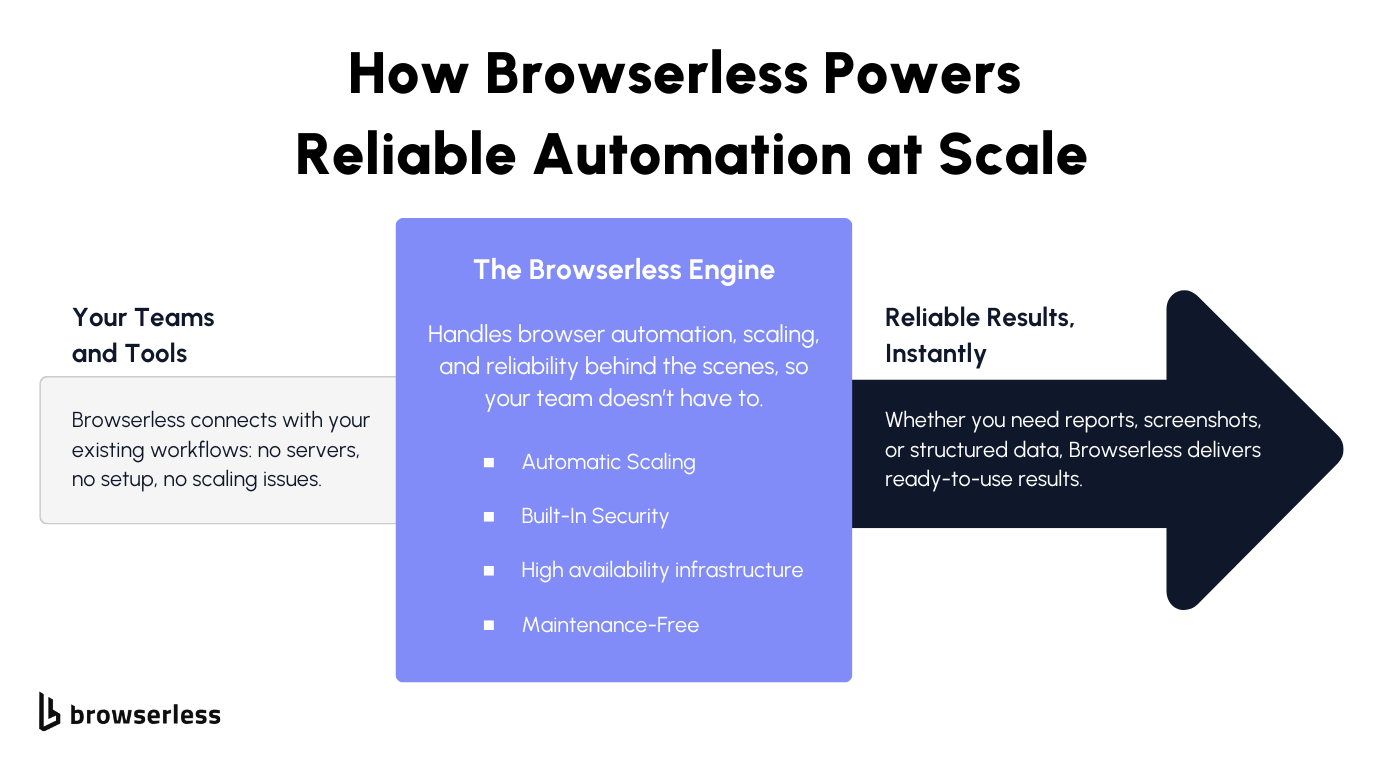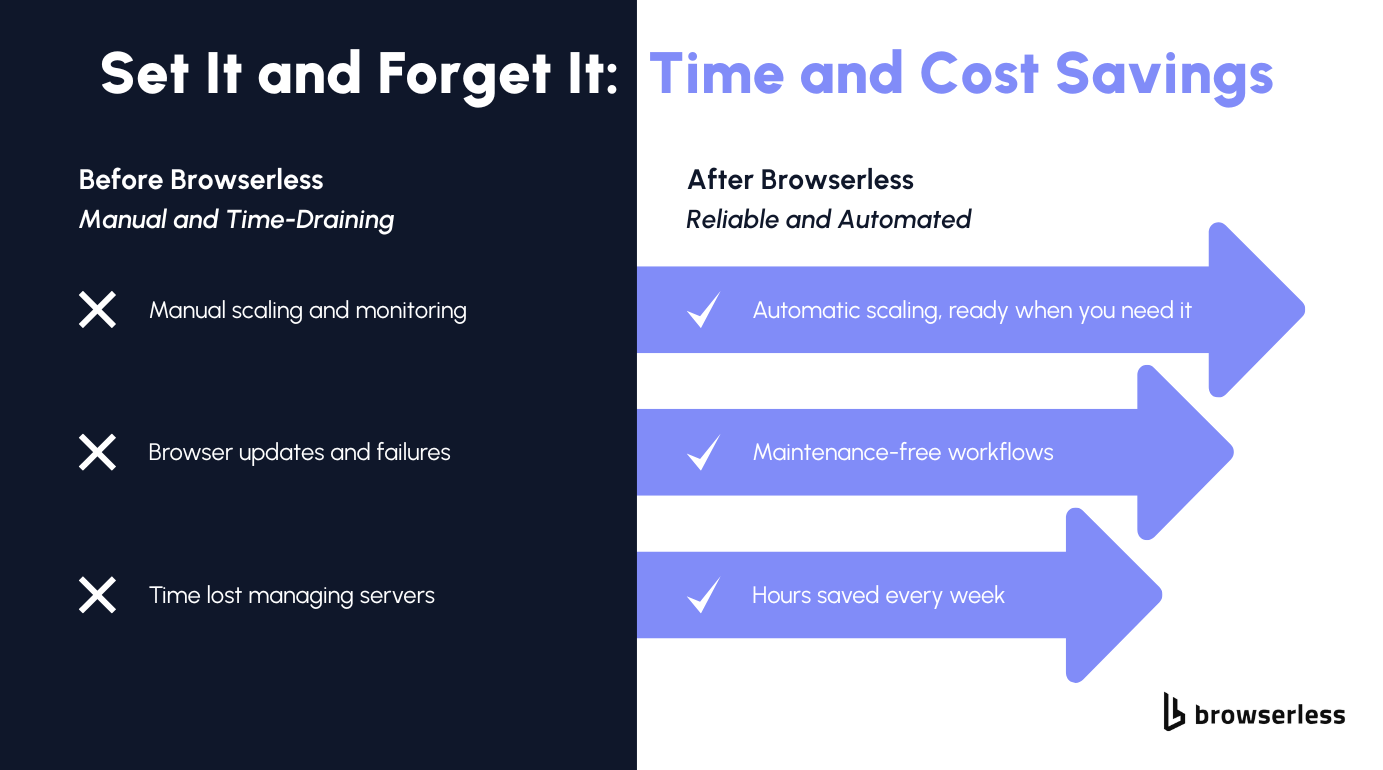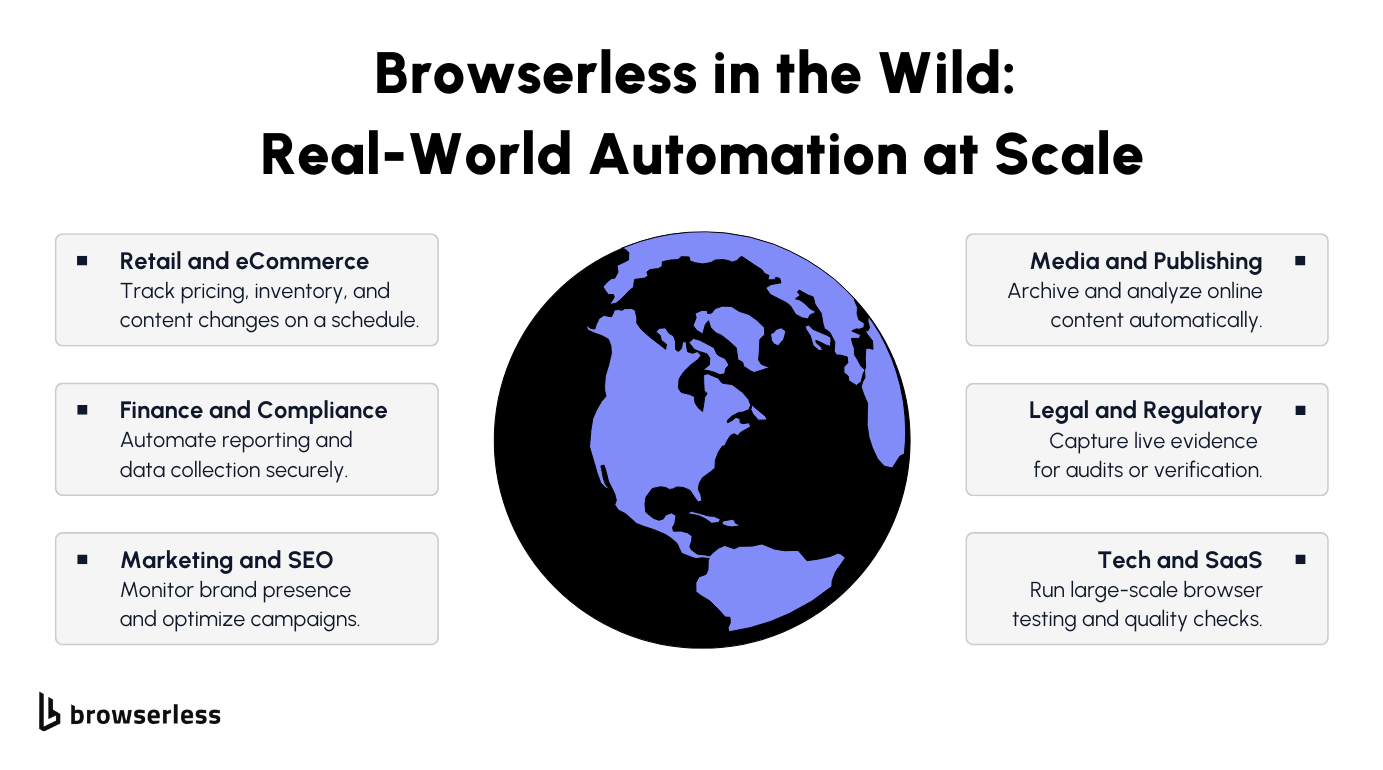Introduction
If you depend on web data for research, monitoring, compliance work, or daily decisions, you’ve likely run into the frustrations of managing your own browser automation. A small script might work for a bit, then fail without warning. Browsers freeze, tasks stall halfway through, and you end up fixing the same issues over and over instead of focusing on the data you need. Browserless reduces that effort by providing APIs that run headless browsers without you having to host or maintain the environment. In this article, you’ll see how this setup works, why it can improve reliability, and how it helps you spend less time fixing tools and more time using the results.
When a Simple Script Becomes a Business Operation

From Quick Fix to Critical System
A lightweight script often starts as a quick solution to pull data or generate a routine report. It runs on a developer’s machine or a simple server, and expectations stay low because it wasn’t meant to support anything significant.
Over time, though, that script becomes a dependable source of numbers, snapshots, or updates that others rely on. It might populate dashboards, feed internal tools, or support a recurring workflow.
Once it reaches that point, the setup needs more than casual attention. A single failure can delay reports, create data gaps, or lead to manual fixes that eat up hours. What began as a convenience becomes something other parts of the business expect to be reliable.
If the automation still depends on a single person’s environment or on a browser that has to stay running on a single machine, the workflow becomes fragile. Even small interruptions like a browser crash or a version mismatch can slow down a team that depends on timely results.
The Hidden Cost of DIY
Running browsers in the cloud seems straightforward on paper, but it quickly expands into a list of responsibilities. You need a machine to host the browser, a way to keep that machine healthy, a method to rotate or configure proxies, and a plan for handling browser version updates. Each piece adds work and increases the chances of something breaking.
As the workload grows, engineers spend more time dealing with setup issues: stale sessions, memory leaks, timeout errors, mismatched Chrome versions, or scripts that behave differently across environments. These issues don’t always surface immediately, so diagnosing them often requires digging into logs, recreating environments, or patching temporary fixes.
Browserless simplifies this by providing an API that handles the browser runtime for every request. You send the task, such as loading a page, generating a screenshot, or running custom logic, and the service returns the result using a fresh, managed browser session. This removes the need to maintain servers or tune browser settings, making the automation easier to scale as your requirements grow.
The Browserless Advantage: Reliable Automation at Scale

A Hosted Service for Headless Browsers
With Browserless, you get a hosted way to run headless browsers through simple API calls, making automation easier to manage as your needs grow.
Instead of maintaining your own servers or containers, you can send a request and receive the result, whether you’re loading a page, generating a screenshot, creating a PDF, or running custom logic.
Each task runs in a fresh browser environment, helping avoid issues caused by leftover data, cached resources, or inconsistent environments.
The service also keeps its browser versions up to date, so you don’t have to track releases or adjust your setup every time a new version comes out.
Everything runs in a consistent, managed environment, which helps automation behave consistently across different workflows. This lets you support browser-driven tasks without maintaining the underlying infrastructure yourself.
Always Updated
Browserless keeps its browser environments up to date for you. There’s no need to handle patches, review version changes, or troubleshoot mismatches between local machines. The service manages browser updates for you, giving your automation a stable, predictable environment without ongoing maintenance.
Set It and Forget It: Faster Launches, Lower Complexity

Start Quickly with REST APIs
You can start using the service quickly without installing a browser or setting up your own server. This helps you move from a simple test to a working automation without spending time on setup or configuration.
You can focus on what you want the automation to do, instead of dealing with the system behind it. As your needs grow, you can keep using the same API calls. You don’t have to rebuild anything or switch to a different setup just because your workload increases.
Focus on Insights, Not Browser Setup
Running your own headless browser often means dealing with updates, patches, and unexpected issues. With Browserless, that maintenance work is handled for you. You don’t have to keep track of browser versions or worry about which machine is running what.
It also avoids the common problems caused by mismatched environments or missing dependencies. Each request runs on a consistent setup, so you spend less time fixing issues and more time working with the results.
This gives engineers more room to focus on building and improving automation workflows rather than troubleshooting browser-related issues.
Don’t Reinvent the Wheel: See It Working in the Wild

A hosted browser service is often used for routine tasks that need to run reliably without the effort of maintaining a browser setup yourself. These examples reflect how teams actually use browser automation today and what they gain from it.
- Retail Track product prices, stock levels, and page updates across many online stores. Automation checks these pages regularly and returns clean data or screenshots. This helps teams stay updated without having to manually open a long list of pages every day.
- Finance Capture dashboards, charts, or regulatory pages that don’t offer simple export options. Automated PDFs or screenshots create a consistent record that can be shared internally or stored for reporting. This eliminates the need for someone to log in and manually capture the same information.
- Marketing Monitor competitor landing pages, promotional changes, and messaging updates. Scheduled captures make it easy to review how pages change over time without having to check them yourself repeatedly. This supports campaign tracking and helps teams stay aware of shifts in competitor content.
- Media and Research Save snapshots of live content such as headlines, article revisions, or rapidly changing pages. You can save automated captures with their date so you keep a clear record that editors or researchers can reference later. This makes it easier to track content changes or keep an accurate log of what appeared at specific times.
Scale Without Growing Headcount
When automation starts to grow, the browser environment often becomes the part that needs the most care. With a hosted service handling the browser-runtime layer, you do not have to manage servers, keep machines running, or worry about keeping different environments in sync.
You send a request, the service runs the task in a clean browser, and you get the result back. This keeps the setup lightweight, even as the number of functions increases.
You also get a consistent environment for every request. Scripts behave the same way across different workflows because they run against the same browser setup each time.
That makes it easier to expand automation without adding new infrastructure work or shifting responsibilities to engineering teams that are already busy.
Conclusion
Managing headless browsers on your own can become complicated as automation grows. A hosted service like Browserless simplifies this work by offering APIs for screenshots, PDFs, and other browser-based tasks without requiring you to maintain the underlying environment. This helps reduce the time spent dealing with browser setup and lets teams stay focused on building the automation workflows they care about. Start your trial today and see how much easier your automation can be with Browserless.
FAQs
What problem does Browserless fix for people who rely on browser automation?
It takes away the hassle of running your own headless browsers. Instead of dealing with crashes, updates, or broken scripts, you send Browserless a request, and it handles everything in a clean browser session. This helps your automations run more smoothly.
How does Browserless make web scraping and data collection more reliable?
Every job runs in a fresh browser that Browserless prepares for you. Nothing carries over from a previous task, reducing errors. You also don’t need to worry about keeping Chrome up to date or matching your local setup.
Why use a hosted browser service instead of running Puppeteer or Playwright yourself?
Running your own setup seems simple at first, but it gets harder as your needs grow. You would have to maintain servers, fix crashes, manage proxies, and update browsers. With Browserless, you just send a request and get the result. That makes everything easier.
What everyday tasks can Browserless help automate?
People use it for price checks, stock tracking, saving screenshots, creating PDFs of dashboards, watching competitor websites, and capturing news or research pages. These tasks need a stable browser, and Browserless provides that without extra work.
How does Browserless help teams scale without adding more maintenance?
You don’t need to manage extra servers or complicated setups when using the hosted service. Each job runs in a clean browser, so results stay consistent even as you send more requests. This keeps things simple as your automation grows.
